Your business plan is the first big step that you need to take on the road to establishing your company. It acts as the blueprint for the future of your endeavour and will be a vital building block in generating the early DNA sequences of what will hopefully grow into a successful venture.
But what exactly is a business plan? And factors do you need to consider when creating one? If you need help in taking your first steps in crafting your business plan, or you’re looking for any final flourishes to appeal to investors, or you simply want to compare and contrast your existing plan, this ultimate guide will be packed with actionable advice and insight.
Regardless of whether you have a clear idea of the direction that you want your company to take, or you’re eager to cement your ideas in a comprehensive plan, a business plan is a great guide in your business for raising the much-needed capital to take your next steps – making this part of the process vital to the success of your business.
So, how do you go about writing the perfect business plan? In many cases, getting started can be the trickiest part. This article outlines all the steps you need to take on the way to creating a winning business plan. But first, let’s define exactly what we’re talking about when we discuss business plans:
What is a Business Plan?
In a nutshell, a business plan is a document that simply outlines your business goal and puts into detail your plan to achieve those goals. Your business plan exists as a living document that maps out the viability of your ideas and shows the world that they’re capable of being turned into a reality.
Significantly, business plans will also help investors to understand your business, your vision, and can convince them to invest in your idea. Your business plan stands as well researched, concrete evidence that your endeavour will not only be profitable, but also sustainable.
Why Business Plans are Important
At this stage, it’s worth distinguishing the value that business plans hold. It’s also worth noting that the creation of a business plan isn’t essential to a successful business. There are some cases where entrepreneurs have been highly successful without ever having to put pen to paper in drafting a business plan – the decision to sidestep the crafting of a plan could be down to past experiences, a lack of competition, or maybe a reliance on pure luck, but in some cases, success can be achieved without it.
Despite this, the fact remains that a great many entrepreneurs fail due to a lack of planning too. Whether complacency enters the fray, or founders believe in the power of their vision a little too much, Some entrepreneurs believe that they’re capable of progressing their endeavour without a plan behind them. However, the stats show that this is a highly risky game to play:
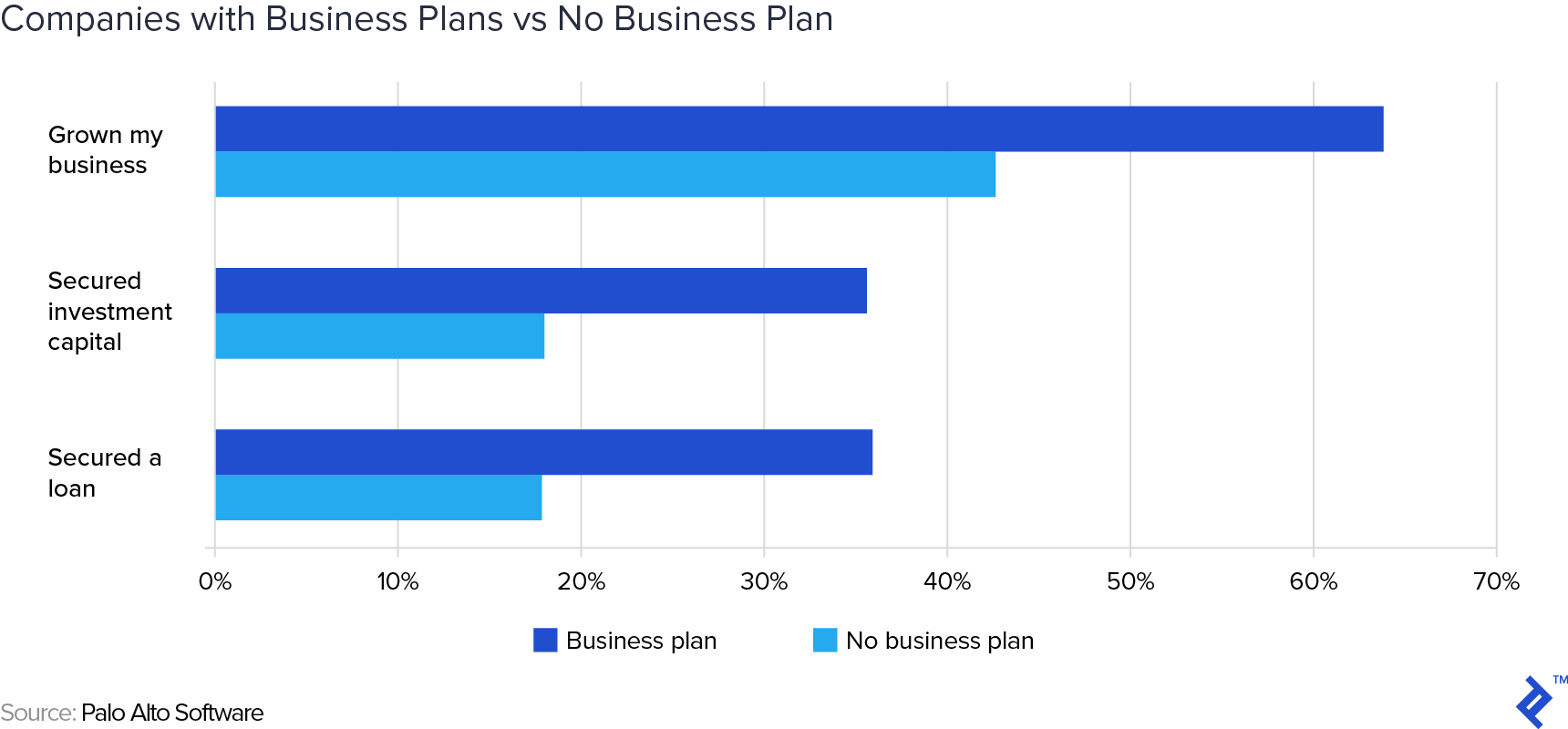
(Image: Toptal)
As the chart above shows, twice as many businesses that utilise plans go on to secure loans compared to those without business plans, and the same goes for companies securing investment capital. Meanwhile, 20% more entrepreneurs have found themselves able to grow their business whilst having a functioning business plan at their disposal.
Business plans are your companion for your entrepreneurship journey. By creating one, you’ll have a functioning document by your side to help your team better understand your challenges and the competition you’re set to counter throughout your journey. Business plans can help to keep you and your team in sync and on the same page as you achieve your goals and scale your company.
What Ingredients Should You Include in Your Plan?
Writing a business plan helps you to spend time contemplating your future actions and to better understand what you intend to do with your venture.
The key ingredients to consider adding to your business plan can you and those around you to commit established goals and objectives to an achievable road map. Be sure to take the time to consider some of the following factors when crafting your plan:
- Set out a coherent strategy and action plan for the future. This can detail your intentions for the next year, three years, or the course of the next decade – it all depends on your vision and quality of insight. However, try to refrain from making assumptions as you cast your mind further into the future.
- Establish concrete objectives and address how you intend to go about achieving them.
- Seek to write your plan in a way that helps you to develop your ideas. As you establish your focus points, your priorities can be identified, while less important factors are dropped – helping to make your business more efficient in its growth.
- Train yourself to enjoy looking for holes in your plan. Although it can be annoying when things don’t add up, your business plan is the perfect place to prevent inconsistencies snowballing into big problems later on.
- Design your plan with the intention of making it the benchmark for the performance of the business. When it comes to monitoring your growth, compare your progress to how you’ve anticipated your growth in your plan.
- Write your business plan in a way that can be shared with your employees. By involving them in the planning process you can establish a tone with considerations made that reach all the way across your staff.
Here, it’s worth reiterating that you might need to share your business plan with outsiders who aren’t staff or stakeholders in the business. This could happen if you’re intending to seek external financing sources. With this in mind, here are some further considerations to make before delving into structuring your plan:
- Your business plan will become essential for your growth if you’re looking to raise finance from a bank or venture capital firms. Remember to write your plan with this in mind.
- Anticipate that your plan could one day be used to help you to attract new members of senior management or secure business partnerships like distributors or agents.
- Always adapt your business plan to suit its target audience. If you’re going to use the plan to achieve funding, tailor it towards venture capital firms and angel investors. If you’re planning on bootstrapping, craft your plan more for the reference of internal team members and stakeholders.
- To help to achieve your goals within your business plan, it’s worth asking an intended recipient about the subjects they’re most keen to see addressed, or whether there’s a specific template they would like you to adhere to.
How to Write Your Business Plan: Step by Step
Let’s now focus on the actual crafting of your business plan. Firstly, business plans typically range to about 15 to 25 pages in length, depending on a wide range of factors regarding whether you’re planning on releasing a new product, or you’re venturing into a brand new industry, or you’re aiming to secure funding from an investor. These factors will determine things like the level of financial information you’re obliged to include and the timeframe of your growth projections.
For the benefit of this guide, let’s take a deeper look into a typical business plan. The structure of a traditional plan can be broken down into seven sections, which we’ll address one by one:
Section 1 – Executive Summary: This section typically follows straight on from your title page and its purpose is to set out and explain the fundamentals of your company – from its USP to a concise synopsis of your plan that addresses your idea, the financial fundamentals behind it and your expected funding requirements.
Clearly setting out your financial projections and requirements can be a key part of your business plan depending on whether you intend to access funding, so it’s important to acknowledge your cash flow and sales projections alongside the level of capital that you’ll need.
Your executive summary also needs to address the current business position of your company, such as its legal form of operation, how long it’s been operating, a brief staff overview and key principles. Also be mindful of stating your intangible assets, like patents, operational prototypes and brand presence.
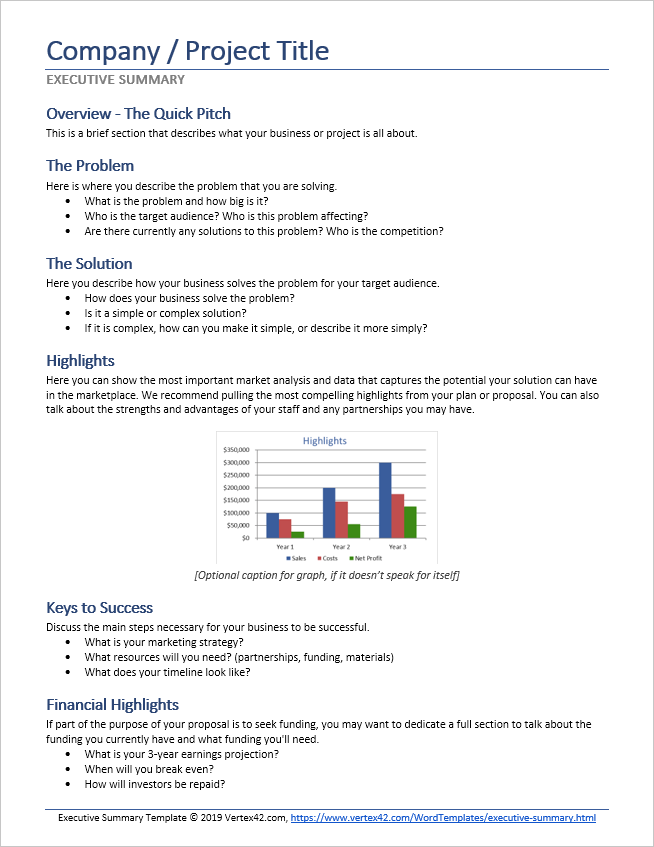
(Image: Vertex42)
As we can see from the above executive summary template, the role of the executive summary is to offer an overview of the company, its goals, operations, and financial information. This snapshot of your business is an essential part of your plan because it helps those who aren’t actively involved with your company to quickly understand what makes you tick, and how lucrative investment in the business may be.
Perhaps most importantly, your executive summary can state your case to prospective investors who don’t have the time to sift through scores of cash flow forecasting and simply want to quickly work out whether your venture is worth looking into.
Section 2 – Business Description: Your business description should begin with a broader focus on your industry and the potential opportunities it holds for your idea. Address the various markets within the industry and highlight potential new products that could benefit or hurt the development of your company.
If you’re looking to access investment, this is your opportunity to reinforce your data with trustworthy sources and footnotes. Most competent investors will be eagle-eyed in finding inconsistencies, and the last thing you want is to undermine your credibility with shady reference points.
This is also your chance to describe your business structure in detail for the first time. Acknowledge how you plan on leveraging sales, who you intend to sell to, how you’re going to distribute your products and services, why your product or service is better than anything that already exists on the market, where your business legal structure stands and your own personal values and why they make you an asset to the endeavour.
One of the greatest assets that an entrepreneur can possess is their passion for turning their ambitions into a reality. In this section, you get the chance to really show your passion, enthusiasm, and market knowledge to win the confidence of your readers – whoever they may be.
Section 3 – Market Strategy: In detailing your market strategy, you can successfully define your target market and address how you’re intending to appeal to them.
Again, if you’re aiming to appeal to prospective investors, or you’re planning on establishing strategic partnerships with other organisations, your market strategy will be arguably your most important section. This is because confidence in your business can be built by your ability to spot an opportunity to win customers where other businesses are yet to fully capitalise on the market potential.
With this in mind, analyse your market in terms of size, structure, growth potential, emerging trends, social media sentiment and growth potential. This section should also cover factors like distribution plans, touch on promotion strategy and the achieving of your various business plans through accessing the right market.
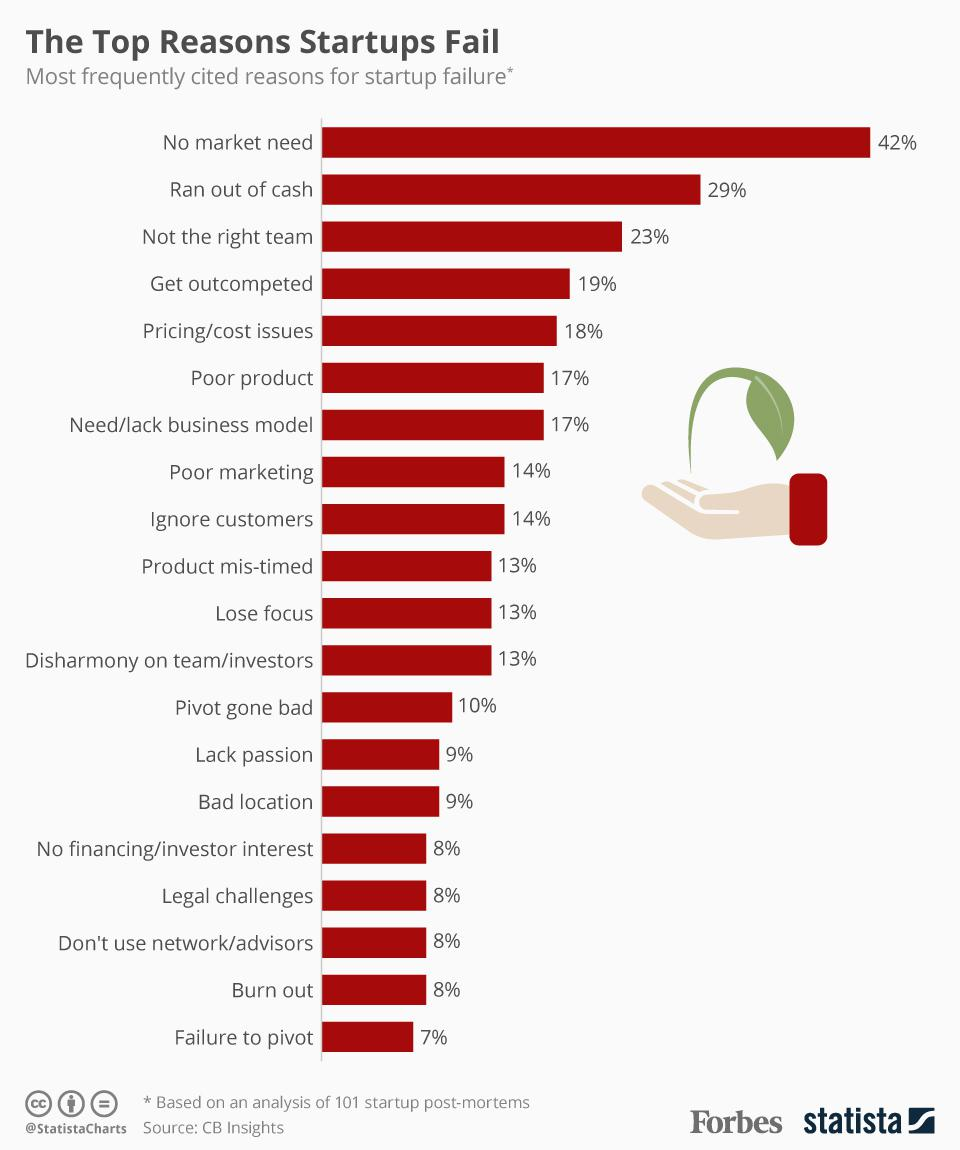
(Image: Statista)
As the chart above shows, the top reason why startups fail is down to there being no market available for a venture to move into. As this reason was cited in 42% of failed startups, it’s imperative that you dedicate a fair amount of consideration to it within your business plan.
Successfully identifying a market for your business and its products or services within your business plan extends way beyond simply appealing to investors – it could make for a key stepping stone in the development of your company.
Section 4 – Competitive Analysis: This section helps you to underline the strengths and weaknesses of your competitors within your market. Here, it’s important to address the strategies that will help you to gain a competitive advantage while also acknowledging the barriers that you can build to help protect your business against new competitors challenging you over the coming years.
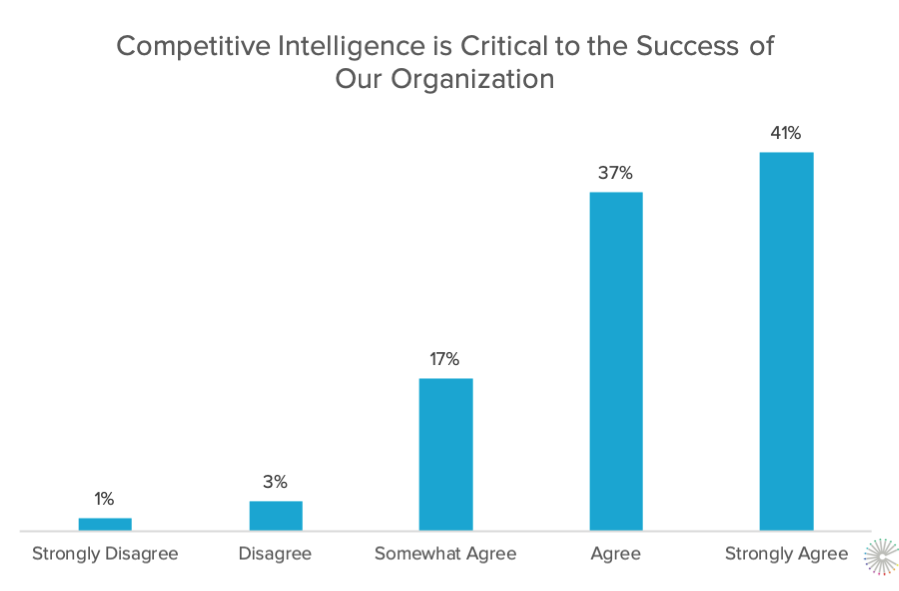
(Image: IMPACT Branding and Design)
As the chart above shows, competitive intelligence is about more than just filling up space in your business plan. As much as 78% of business professionals either agree or strongly agree that competitive intelligence is critical to the success of their organisation.
By committing your competitive analysis to paper, you can deliver an overview of the dangers that your business faces in terms of rivals selling similar products. When you believe you have a winning idea, sometimes it can be tempting to dismiss rival companies and their products as inferior, but it’s essential to the success of your business to seek out potential vulnerabilities at the business plan stage – it will pay dividends as you begin to emerge in your market.
Section 5 – Design and Development Plan: Before we address this section it’s worth noting that a design and development plan is only required if your venture has a product in development – like an app or prototype. Your design and development plan helps to offer investors or stakeholders a comprehensive insight into your product, detailing its design, charting its development within the context of production and marketing, and displaying an easy-to-follow development budget that aligns with the company’s mission statement and goals.

(Image: Pinterest)
As the example above shows, the design and development plan section can be largely visual and coordinated in a way that will be easy for potential investors to follow without the need for high volumes of text-based data.
Section 6 – Operations and Management Plan: Another important section is your operations and management plan. Here, you need to describe how your business functions on a daily basis, as well as where you intend it to be – whether it’s an office or warehouse-based or even remote – and the equipment, staff, processes and environment around your company.
Take the time to consider your products and whether they need to be manufactured. If they need to be constructed, detail how and where this process will take place. It’s also important to cover factors like your facilities, the personnel within your company, the legal environment in terms of licensing, permits, special regulations, suppliers and your inventory. This section also addresses the logistics of the organisation like the responsibilities of your key staff and the operations that are delegated to different departments within your business structure.
Section 7 – Finance: Traditionally, financial data always comes at the back of your business plan. Despite its less-than-prominent position, it’s worth remembering that this section is likely to be your most important. It’s where you can show the world that you’re capable of making money and growing in the future.
The financial data you add to this section tends to include a personal financial statement, startup expenses and capital. You must also include graphics detailing your projected cash flow statements and 12-monthly profit-and-loss statements. It’s also worth adding your business valuation to your finance section, which can be an effective way of clarifying where you currently see your company before it undergoes a scaling process.
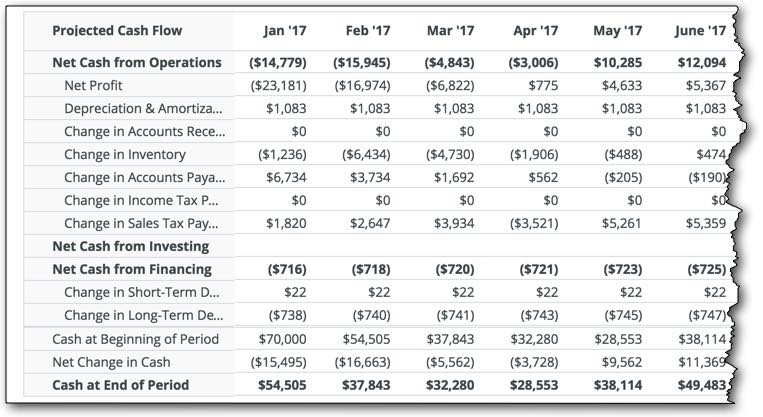
(Image: SmallBizClub)
As we can see from the example above, there are plenty of considerations to make when charting your projected cash flow. While this may seem like a daunting task, there are plenty of strong templates to get you started.
Again, if you’re aiming to show your business plan to potential investors, proving your financial competence is essential. For this reason, it’s vital to check and double-check that you’ve covered all considerations in your financial plan. If a bank is looking at your financials before deciding to offer a business loan, you’d better believe that they’ll be eagle-eyed in spotting any evidence of inconsistencies.
Tying Your Key Points Together
It may be worth trying your key points together in the form of a conclusion at the end of your business plan, similarly to how you would conclude an essay. This helps you to touch base with the key points and ideas addressed in the body of your paper, and it could be highly useful for readers following a lengthy 25-page plan.
By making sure your most appealing points hit home, you can refresh the minds of your readers and help to resonate with them better – which can be highly advantageous if you’re looking to maximise your chances of securing funding.
Consider introducing a bullet-pointed walkthrough of your business proposal, addressing the reasons why you believe that your idea will succeed. Reiterate your mission statement, USP, market opportunities, competition weaknesses, the skills of existing team members and your financial competence.
Use Templates to Help Generate a Winning Plan
There is plenty of high-quality business plan templates out there, many of which are oven-ready, meaning that you simply add your business information and data in the pre-prepared sections and prompts.
However, if you’re struggling with where to start in committing your ideas to paper, it may be worth zooming out and utilising a business model canvas to help you to effectively format your plan.
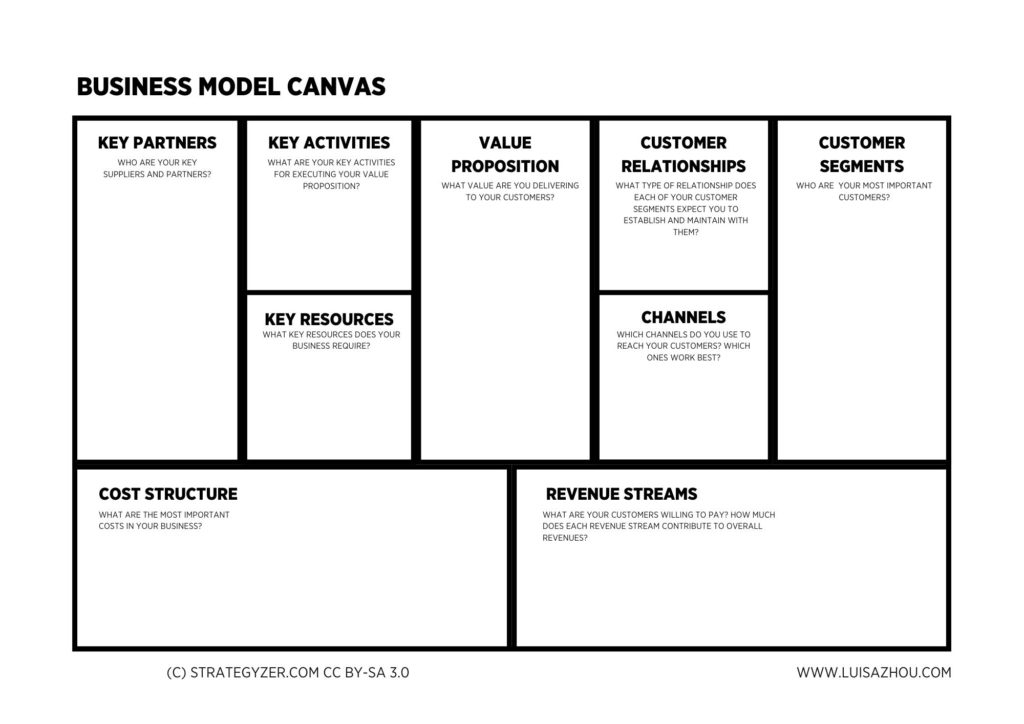
(Image: Luisa Zhou)
Initially created by Alexander Osterwalder in 2005, the business model canvas takes the form of a modular chart that’s broken down into various ‘building blocks.’ This can help you to list out every key point you need to address in various stages of your plan whilst giving you space and overhead view you may require to structure and layout your plan effectively.
For some businesses, it may even be possible to create an entire functioning business plan within the business model canvas, but this is dependent on your intended use cases. Regardless of how you intend to use your canvas, it can make for the perfect starting point to begin addressing the metrics surrounding your business and turning them into key discussion points.
This business plan ultimate guide has hopefully helped to introduce you to business plans, their purpose, and the information you need to include in them. At a time when standing out from the crowd can be fairly tricky to do, a strong business plan will help you to make yourself more visible to investors and better informed when it comes to taking those all-important next steps.








